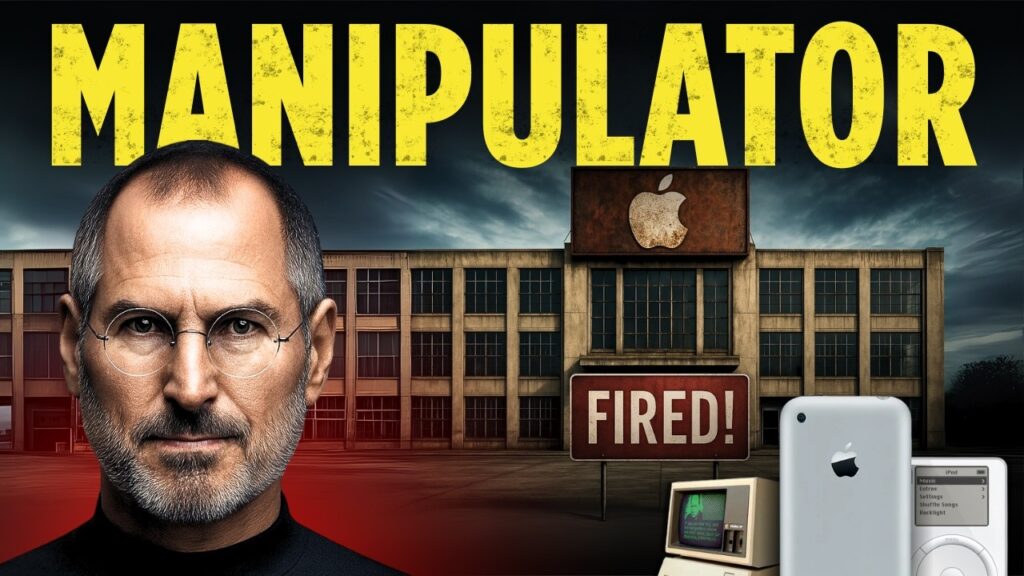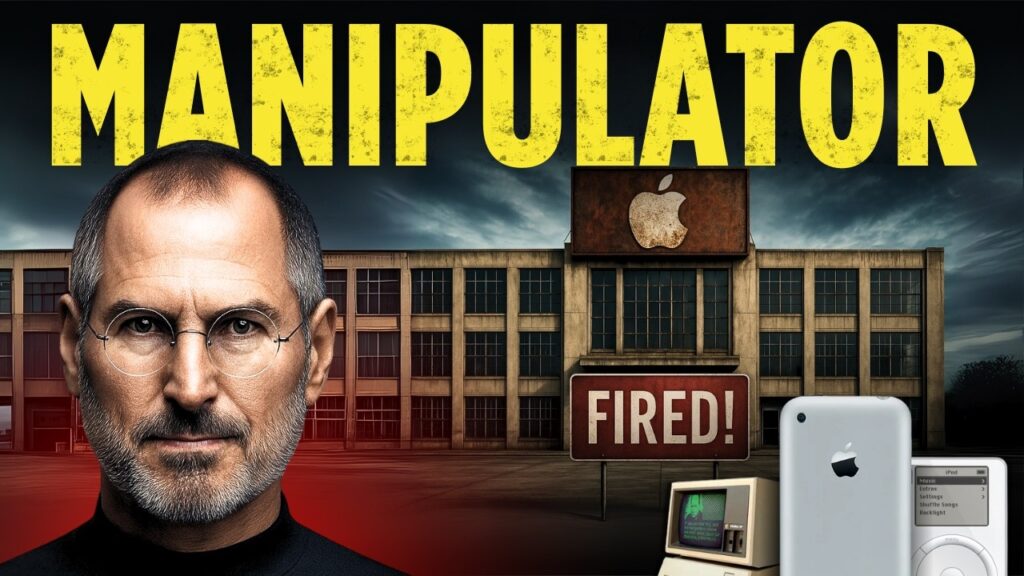Steve Jobs is often celebrated as a visionary leader, the mastermind behind Apple’s revolutionary products like the iPhone, iPad, and iMac. His image as an innovative genius has been meticulously crafted through mainstream media and countless YouTube videos. For years, I admired him, even keeping his photo in my office as a symbol of inspiration. However, recent discoveries have shifted my perspective dramatically, revealing a side of Jobs that is rarely discussed. Was he truly a visionary, or was he a manipulator who built his empire by taking credit for others’ ideas? This article dives into shocking revelations, backed by original FBI documents and accounts from former Apple employees, to uncover the hidden truth about Steve Jobs.

The Myth of Innovation
Mainstream media portrays Jobs as the architect of groundbreaking technologies. But documents not easily accessible in the public domain tell a different story. Former Apple employees have revealed troubling aspects of Jobs’ behavior, describing him as impatient, temperamental, and often unkind. His relentless pursuit of his vision came at a cost—strained relationships, sacrificed personal lives, and a work environment marked by fear.
One striking example is the secretive “Purple Project,” which led to the iPhone’s creation. In 2001, Apple employees were abruptly assigned to a classified project without details, requiring immediate commitment. Those who agreed were divided into two teams, P1 and P2, and confined to secretive “Purple Rooms” monitored by CCTV. Strict non-disclosure agreements (NDAs) ensured silence, even to family members. Jobs enforced such secrecy that employees feared job loss or legal consequences for any leaks. Engineers later revealed that the project disrupted their personal lives, sleep cycles, health, and work-life balance, with some even attributing divorces to the intense pressure. On January 9, 2007, Jobs unveiled the iPhone at San Francisco’s Moscone Center, presenting it as a game-changer. But was it truly his innovation?
The Truth Behind the Touchscreen
The iPhone’s defining feature—its capacitive multitouch screen—set it apart from competitors like Samsung, Nokia, and HTC. Unlike the resistive touchscreens of earlier devices like the IBM Simon or Windows Pocket PC, which required a stylus or firm presses, the iPhone’s smooth, responsive multitouch enabled pinch-to-zoom and intuitive gestures. Jobs called it Apple’s greatest invention. However, the multitouch technology wasn’t Apple’s creation.
In 1965, engineer E.A. Johnson developed a touchscreen prototype for traffic control. Inspired by this, in 1982, Nimish Mehta, an engineering student, created the first human-controlled multitouch device. By 1998, two PhD students from the University of Delaware founded FingerWorks, launching the world’s first touchscreen keyboard to reduce muscle strain. In 2005, Jobs acquired FingerWorks and integrated their technology into the iPhone. Despite marketing multitouch as his own, Jobs never invented it. Instead, he capitalized on others’ innovations, a pattern that would repeat.
The Atari Breakout Incident
Jobs’ manipulative tendencies surfaced early. In 1973, at age 18, he joined Atari as an engineer despite lacking formal technical knowledge. His hiring was unconventional—after refusing to leave an interview, he convinced Atari to take a chance on him. Tasked with developing the game Breakout, Jobs enlisted his friend and Apple co-founder Steve Wozniak, a technical genius. Wozniak worked tirelessly for four nights, creating the game with just 44 chips, far fewer than the 150+ typically used. Impressed, Atari awarded Jobs a $5,000 bonus. However, Jobs told Wozniak they received only $700, splitting it equally and pocketing the remaining $4,650. This betrayal highlights Jobs’ willingness to exploit even close relationships for personal gain.
Reality Distortion Field
Jobs’ “reality distortion field” was a term coined to describe his ability to bend perceptions, often taking credit for others’ ideas. Employees reported that Jobs would dismiss their ideas as “stupid,” only to later present them as his own with slight modifications. Jonathan Ive, who designed the iMac, iPod, and iPhone, recounted how Jobs rejected his ideas, then claimed them as his own. Similarly, Wozniak’s technical contributions to Apple’s early products were overshadowed by Jobs’ knack for self-promotion.
Perhaps the most audacious example is Jobs’ acquisition of Xerox’s graphical user interface (GUI) technology. In 1979, Apple developer Jef Raskin alerted Jobs to Xerox’s Palo Alto Research Center (PARC), where engineers were developing advanced technologies like GUI, mouse, and object-oriented programming. Recognizing their potential, Jobs struck a deal: Xerox could invest $1 million in Apple in exchange for a tour of PARC. After seeing the technologies, Jobs dismissed them as unimpressive to Xerox, but soon launched the Lisa computer, incorporating the same GUI and mouse concepts. Though the Lisa failed commercially, requiring Apple to bury 2,700 units, Jobs’ actions are considered one of the biggest “tech heists” in history. Quoting Picasso, he justified it: “Good artists copy, great artists steal.”
The Human Cost
Jobs’ leadership style was as polarizing as his innovations. Employees described his erratic behavior—berating staff one moment, then gifting extravagant rewards like a Jaguar to an employee who arrived late due to a car breakdown. His insistence on brutal honesty led to unpredictable reactions. In 1984, employee Guy Kawasaki faced Jobs’ wrath when asked about a competitor, Nowhere, only to learn Jobs had brought Nowhere’s founder to the meeting to test him. Such psychological games created a culture of fear, where employees dreaded his volatile moods.
The NeXT Gambit and Apple’s Redemption
After being ousted from Apple in 1985 by CEO John Sculley, whom Jobs had recruited, he founded NeXT to build advanced computers for universities and researchers. Priced at $6,500 (equivalent to $90,000 today), NeXT’s computers were too expensive, leading to the shutdown of its hardware division by 1993. However, Jobs had a larger plan: a reverse takeover of Apple.
By 1997, Apple was on the brink of bankruptcy, with $1 billion in losses and a failing product line. Jobs convinced Apple to acquire NeXT for $429 million, leveraging his storytelling to sell not just an operating system but a vision to transform Apple. Returning as an advisor, he strategically replaced key Apple staff with NeXT loyalists, regained board trust, and ousted CEO Gil Amelio to become interim CEO. His bold moves, including a $150 million investment from Microsoft in 1997, restored Apple’s credibility. By aligning with Microsoft, Jobs shifted public perception, buying time to launch revolutionary products like the iMac, iPod, and iPhone.
Pixar: The Unexpected Triumph
Jobs’ acquisition of Pixar in 1986 for $10 million, originally a graphics group from Lucasfilm, was a side venture. Initially focused on hardware, Pixar struggled until co-founder John Lasseter proposed making 3D animated films. Jobs struck a deal with Disney, retaining creative control while Disney funded production. The result was Toy Story (1995), a blockbuster earning $350 million globally. Subsequent hits elevated Pixar’s valuation to $1.5 billion. In 2006, Disney acquired Pixar for $7.4 billion in stock, making Jobs Disney’s largest individual shareholder and a board member.
Visionary or Manipulator?
Jobs’ legacy is a paradox. His lack of formal technical knowledge didn’t hinder his ability to build a global empire, thanks to his unparalleled marketing and storytelling skills. He transformed Apple into a lifestyle brand, polishing existing ideas into iconic products. However, his methods—exploiting employees, appropriating ideas, and fostering a toxic work environment—raise ethical questions. Wozniak, the technical brain behind Apple, was often overshadowed, yet he acknowledged Jobs’ indispensable role in marketing Apple’s vision.
Jobs’ hypocrisy is evident in his outrage when Microsoft copied Apple’s GUI for Windows, despite his own “theft” from Xerox. As Bill Gates quipped, “We both had this rich neighbor named Xerox, and I broke in to steal the TV set, only to find you’d already stolen it.” Jobs’ flaws—ego, control, and immorality—fueled his brilliance, making Apple extraordinary but at a significant human cost.
Conclusion
Was Steve Jobs a visionary or a manipulator? Perhaps he was both. His ability to envision technologies like the iPhone and ChatGPT-like concepts decades ahead of their time cements his visionary status. Yet, his manipulative tactics—stealing ideas, exploiting relationships, and prioritizing perception over ethics—paint a darker picture. The Google Doc linked below compiles Jobs’ traits and psychological hacks, offering insights into his mindset for those looking to emulate his success ethically.

